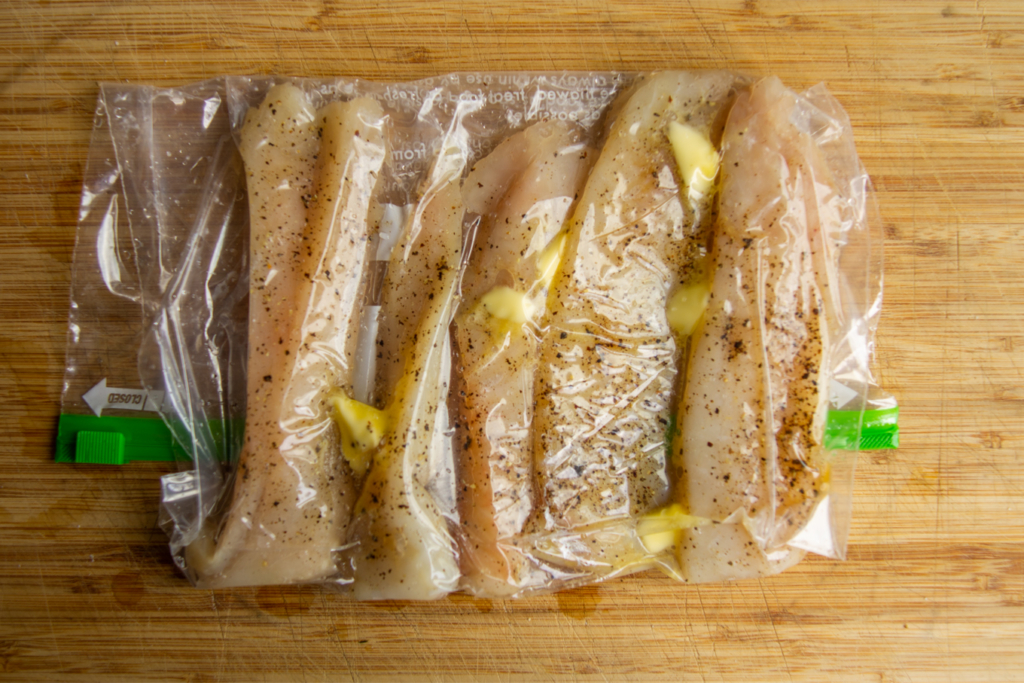Closely related to the cod, pollock is a white flaky fish that is prized for its pleasant texture and delicate flavor. While in the past it was often regarded as a poor substitute for cod and haddock, pollock has had a bit of resurgence in recent years and is increasingly popular in resturants. Like many other white fish, pollock is easy to overcook and therefore ideally suited to precise sous vide cooking. This cooking method allows you to cook this delicate fish to its ideal temperature while also preserving its pleasant texture and flavor. Follow this simple guide to prepare perfectly cooked pollock every time.
Temperature and cooking times for pollock
| Temperature | Time | Result |
| 130°F* | 30-60 minutes | Tender, slightly flaky |
| 140°F | 30-60 minutes | Medium, firm, moist, and flaky |
| 145°F | 30-60 minutes | Well done but still moist, flaky |
As with most white fish, we don’t recommend cooking pollock fillets for longer than 45 minutes. Certain tougher proteins benefit from some extra time in the sous vide water bath, however fish should be removed as soon as possible. If the fish is left in the Suvie or sous vide bath for longer than an hour it will start to develop a dry, unpleasant texture.
Follow this link to find out more information about Suvie cooking times and temperatures.
Ingredients
- Pollock fillets
- Salt
- Pepper
- Olive oil or butter
Equipment
- Suvie or an immersion circulator
- A large pot (if using an immersion circulator)
- Freezer safe sealable plastic bags
Directions

Season the pollock on both sides with salt and pepper and add any other seasonings you like.

Place in a sealable freezer bag (remove air from the bag using the water displacement method). Add 1 tsp of olive oil or some butter and seal the bag.

Vacuum seal bag using our DIY vacuum-sealing guide.
Suvie Instructions
If you are using Suvie, place the bag in the protein pan and cover with water. Cook using the following settings:
Suvie Cook Settings
Bottom Zone: Sous Vide at 130-145°F for 30 to 60 minutes (based on desired doneness)
Top Zone: Sous Vide at 130-145°F for 30 to 60 minutes (based on desired doneness)
Once the cook is finished, remove the fish from the pan.
Remove the fish from the bag and gently pat dry with a paper towel.
Immersion Circulator Instructions
If you’re using an immersion circulator, pre-heat your water bath to the desired temperature.
Gently lower the bag into the water bath and clip to the side to prevent it from moving.
Once the cook is finished, remove the bag from the water bath.
Remove the fish from the bag and gently pat dry with a paper towel.

Serve immediately, or proceed to the finishing step.

Finishing
Sous vide pollock can be enjoyed straight out of the bag, however, if you prefer a light sear follow the instructions below:
Heat 1 tbsp vegetable oil or butter in a skillet over high heat until the pan is very hot. Once the oil begins to smoke place the pollock fillets in the pan. Cook for no longer than 30 seconds on each side. Remove from heat and serve immediately.
Recipes to try
White Fish Rice Bowl

White Fish with Herb Butter over Spinach

Kerala Fish Curry

FAQs
Should I add oil during the sous vide process?
You don’t have to, but we strongly recommend it. Unlike steak or chicken, fish benefits from a little bit of fat during the sous vide process.
Can I leave the pollock fillets in sous vide for longer than 60 minutes?
As with all proteins, at low temperatures, pollock that is left in the sous vide bath for too long will develop a soft texture that some may find unpleasant. At higher temperatures, the fish will become overly dry.
What’s the chalky white substance on the exterior of the fish?
You may notice a white film forms on the exterior of your fish after it has cooked. This is albumin, a water-soluble protein that coagulates when heated and is completely safe to eat. It’s the same protein you find in egg whites and milk. Simply rinse or carefully brush off the albumin with a paper towel to remove.
Note: Adding oil to the sous vide bag should help to inhibit the development of the albumin.
Where can I get vacuum sealed proteins?
If you don’t want to fuss with vacuum sealers and ziplock bags you can skip the store and order the Suvie Protein Box. Just put together your ideal combination of preseasoned, portioned, and vacuum-packed high-quality meat, poultry, or fish. We deliver it to you frozen in a carefully-packed box.



